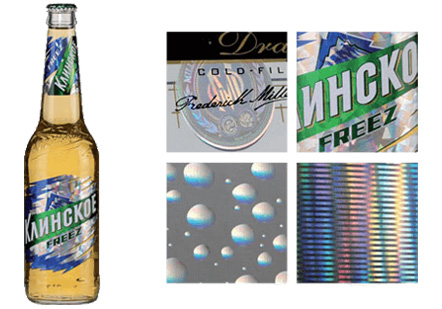Metallised paper is a product coated with a layer of aluminium in a matt or glossy finish that provides decorative and protective properties to the product.
Metallised paper can be manufactured using two different systems.
This process consists of bonding the paper (usually uncoated paper) to an aluminium sheet with a thickness of between 9 and 12 microns. Due to the high consumption of aluminium, this system is being used less and less.
The system we will be looking at in depth is the most commonly used and consists of heating aluminium or other materials in a vacuum chamber, evaporating or sublimating them and then depositing a thin layer on the surface of the coated substrate. In this case, the main advantage is that 300 times less aluminium is used than in the previous case.
In both cases, this type of substrate offers a solution for achieving a unique metallic finish on packaging with a fraction of the aluminium content of conventional foils. Let's look at more details about the vacuum production process.

Wet Strength Holographic Metalized Paper
As mentioned earlier, the best way to produce metallised paper is through vacuum metallisation. The process of producing metallised paper consists of three separate processes, which are
A thin layer of varnish is applied to the coated substrate in order to prepare the surface for subsequent metallisation. The paper is pre-coated with lacquer to smooth the surface, act as a barrier layer between the paper and the metallised layer and improve the adhesion of the vapourised metal. Varnish is applied to the varnish in a process similar to gravure printing. After the varnish has been applied, the paper is passed through a hot air drying unit to remove the solvent from the varnish, thus drying the paper to a moisture content of between 2% and 3%. Next, within the same varnish machine, the paper passes through a set of freezing rollers which prevent the paper from sticking in the winder.
This stage is probably the most critical point in the production process. Once the paper odours have been varnished, they are sent to the metallising area where they are introduced one by one in order to apply the aluminium layer to the paper. The pre-coated paper is then metallised directly. The lacquered paper is placed in the "metallisation chamber" where the aluminium layer is applied by means of an evaporation or sublimation process.
Non Wet Strength Metallized Paper
All metallised papers are then surface coated and rewetted as a final process. Once the reel has been placed in the lacquering machine, the metallised paper is corona treated, which helps to fix the lacquer to the aluminium. This corona treatment works by increasing the surface tension of the metallised surface. Once the corona process has taken place, the lacquer is applied using a gravure system, just as in varnish, followed by drying using a hot air tunnel.
When the product is coloured, it is the lacquer itself that is coloured by the final colour of the product. The classic colour is gold, but from a technical point of view, other colourants can be used if necessary. After drying, the metallised paper is passed through a cooling roller and subsequently subjected to a water and back treatment. This is to ensure that the paper has the final moisture required for the finished product and to maintain flatness when converting it into paper or labels.
The coating protects the aluminium from damage and can be used as a printing primer for a variety of printing applications. A thin layer of lacquer is applied to give the paper its final characteristics such as printing characteristics, colour (e.g. for gilding or matt/glossy finishes).
The resulting product can be recycled in a similar way to other speciality papers.
Metallisation of the product The surface is plastic in nature, or water resistant and non-absorbent. It provides the coated paper with a range of barrier properties, forming a barrier to light, water vapour, oxygen and odours.
Paper can also have special effects that can alter the appearance of surfaces that are normally very smooth. Let us look at two of these.
This effect can be achieved by a proprietary and patented process of micro-embossing, which is used to create the desired visual effect.
This finishing is produced by a physical process, which is used for certain grades and is carried out in the embossing machine.
For more information about types of metallised paper visit this link.
Previous: Is Metallized Paper Food-safe?
Next: What is Metalized Paper?
Copyright © HUBEI Y.F PACKAGING MATERIALS CO., LTD. All Rights Reserved | Sitemap
| Powered by 
Recommend Products: Pressure Sensitive Paper Beer Label Paper Water Resistant Paper for Labels What are the different types of holographic paper?